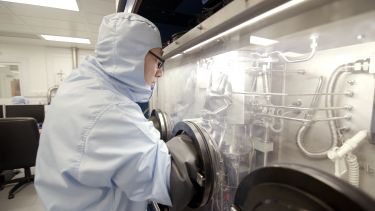Research
The centre will specialise in wide-bandgap semiconductor optoelectronics. The centre will also research next generation information storage, ultra-high resolution displays, next generation biomedical instruments, environmental protection and more.

MOCVD growth of high quality non-polar and semipolar GaN
Development of advanced overgrowth techniques to allow the growth of high quality GaN on substrates in non-polar and semi-polar orientations.
Relevant publications:
- J Bai, Y P Gong , K Xing, X Yu and T Wang, Efficient reduction of defects in (1120) non-polar and (1122) semi-polar GaN grown on a nanorod template Appl. Phys. Lett. 102, 101906 (2013)
- K Xing, Y Gong, J Bai and T Wang, InGaN/GaN quantum well structures with greatly enhanced performance on a-plane GaN grown using self-organised nano-masks Appl. Phys. Lett. 99, 181907 (2011)
Solar hydrogen generation by water splitting using III-nitride materials
III-nitride based devices for photo-water splitting. The chemical stability of nitride materials and the widely tuneable bandgap allows efficient conversion of solar energy to hydrogen as a fuel source.
Relevant publications:
- J Benton, J Bai and T Wang, Significantly enhanced performance of an InGaN/GaN nanostructure based photo-electrode for solar power hydrogen generation Appl. Phys. Lett. 103, 133904 (2013)
- J Benton, J Bai and T Wang, Enhancement in Hydrogen Generation Efficiency Using A GaN-based Nanorod Structure Appl. Phys. Lett. 120, 173905 (2013)
Nanostructures and Photonics
Incorporation of nanoscale structures into III-nitride based optoelectronic devices by application of novel, cost effective device fabrication processes. Allows control over light and carrier dynamics in iii-nitride optoelectronic devices, such as microdisk lasers.
Relevant publications:
- T Kim, B Liu, R Smith, M Athanasiou, Y P Gong and T Wang, Coherent nanocavity effect in InGaN/GaN nanodisk arrays Appl. Phys. Lett. 104, 161108 (2014)
- J Bai, M Athanasiou, T K Kim and T Wang, Enhanced efficiency of InGaN/GaN solar cells with nanostructures Appl. Phys. Lett. 104, 051129 (2014)
Plasmonic Nanostructures
Through the combination of nanoscale metals and III-nitride materials, light-matter interaction can be manipulated. This allows optical fields to be concentrated into sub-diffraction limited volumes.
A plasmonic laser has recently been demonstrated using a single InGaN/GaN nanorod coupled to silver films.
Relevant publications:
- Y Hou, P Renwick, B Liu, J Bai and T Wang, Room temperature plasmonic lasing from a single nanorod with low threshold Scientific Reports, in press (2014)
Hybrid White Light Emitters
The combination of III-nitride based inorganic materials with organic semiconductors allows the development of increased efficiency white light emitting structures. This combines the strengths of both materials classes.
Through the combination with novel nanostructures, it has been possible to utilise high efficiency non-radiative energy transfer coupling between the III-nitride materials and organics.
Relevant publications:
- R Smith, B Liu, J Bai and T Wang, Hybrid III-nitride/organic semiconductor nanostructure with high efficiency non-radiative energy transfer for white light emitter Nano Lett. 13, 3042 (2013)




